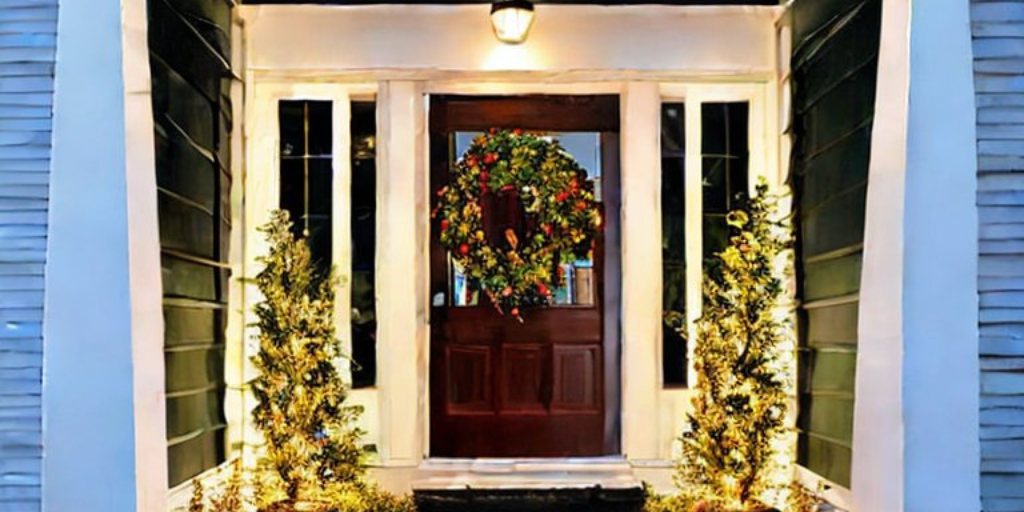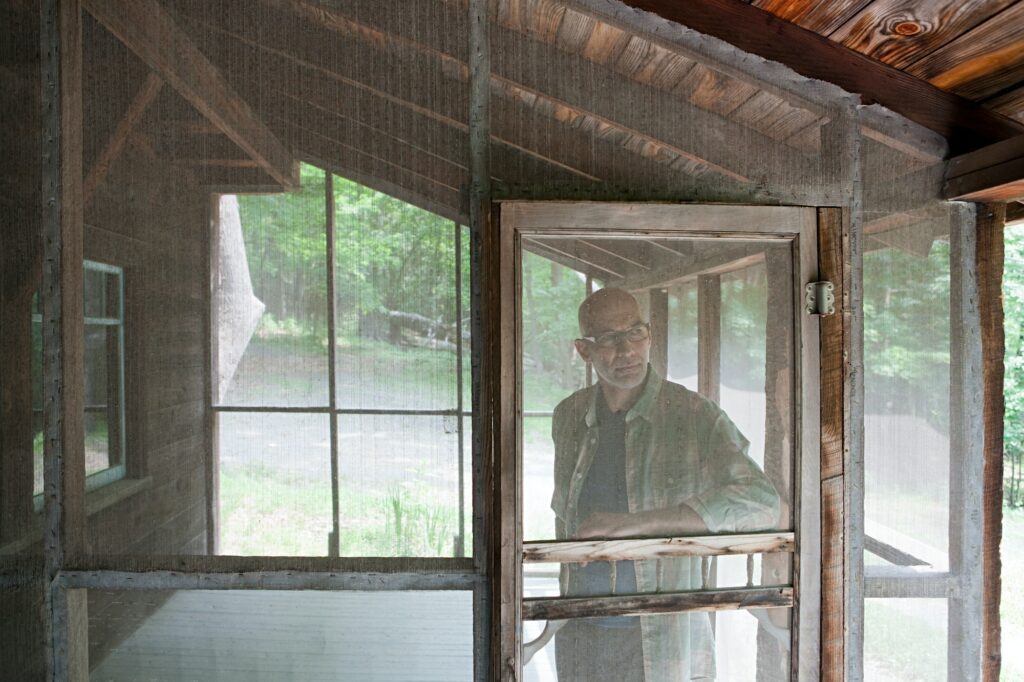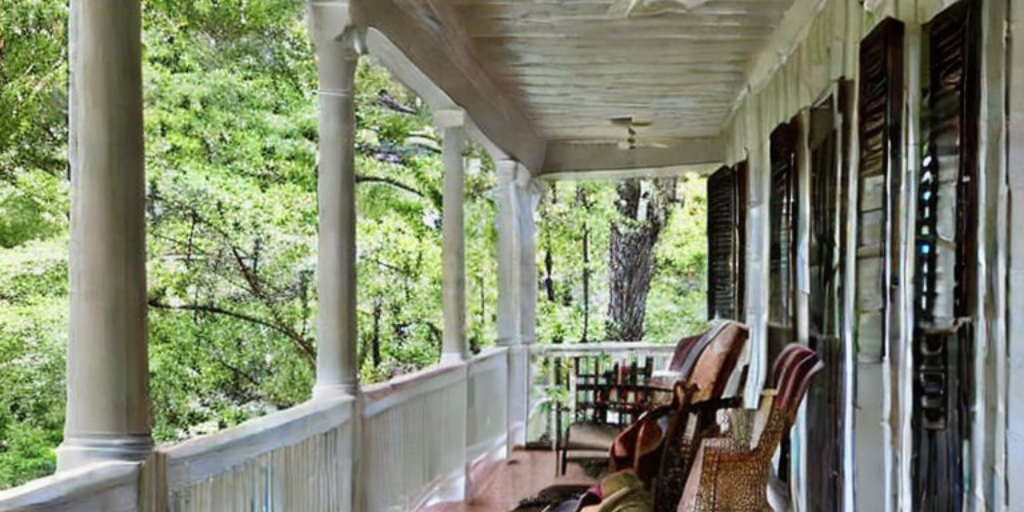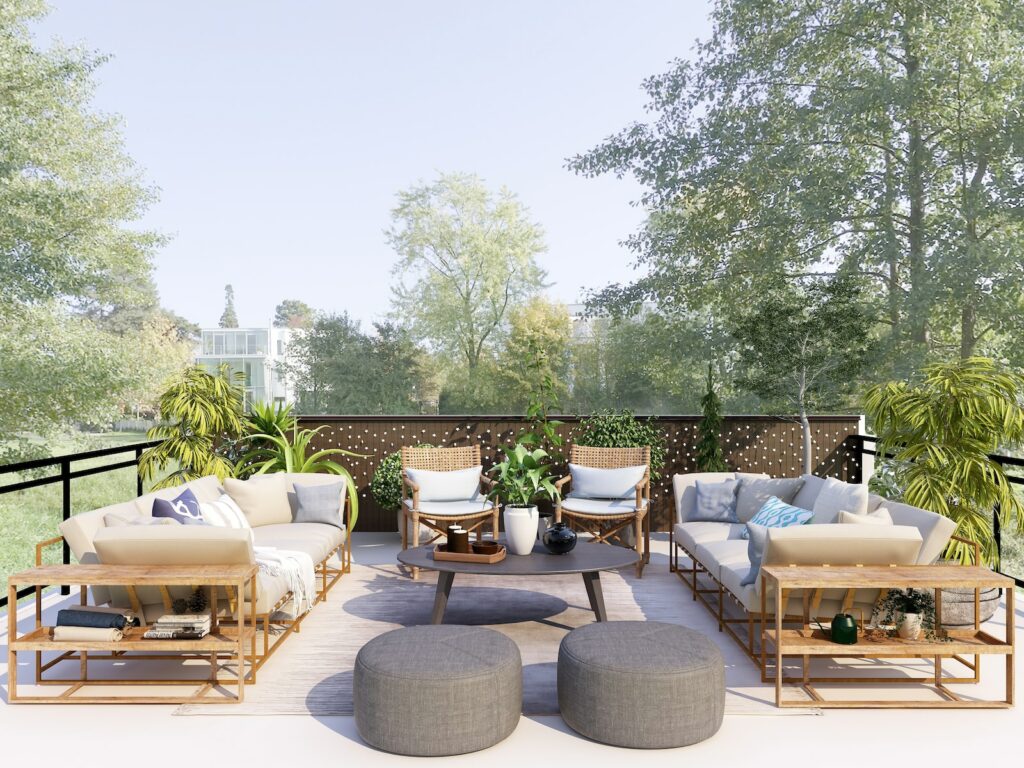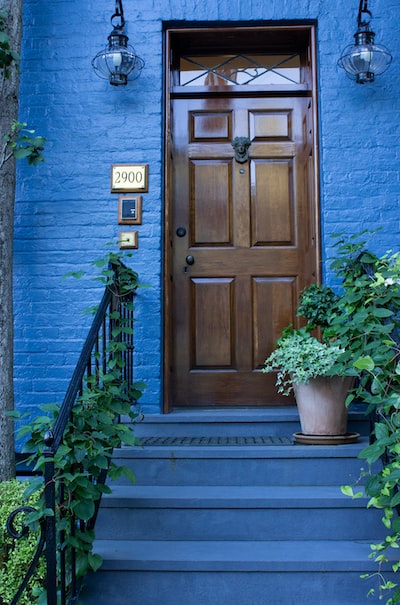Welcome to our comprehensive guide on how deep should a covered porch be as we look at covered porches and their ideal depths. A covered porch is a fantastic addition to any home, providing a sheltered outdoor space to relax, entertain, and enjoy the surrounding views.
One crucial factor to consider when designing or renovating a covered porch is its depth. The depth of a covered porch plays a vital role in its functionality, aesthetics, and overall comfort. In this article, we will delve into the topic of porch depths, discussing the factors that influence the ideal depth, exploring different design considerations, and providing useful tips for creating the perfect covered porch for your home.
How deep should a covered porch be?
Contents
- 1 How deep should a covered porch be?
- 2 Design considerations for the ideal covered porch depth
- 3 How deep should a covered porch be for outdoor entertaining?
- 4 How deep should a covered porch be for adding plants and decorations?
- 5 How much clearance space is needed for a covered porch?
- 6 How deep should a covered porch be for seating arrangements?
- 7 FAQs about covered porch depth
- 8 Q: Are there any building codes regarding the depth of a covered porch?
The depth of a covered porch is an important consideration when designing or renovating outdoor spaces. While there is no definitive answer to how deep a covered porch should be, there are several factors to consider that can help determine the ideal depth for your specific needs. Here are some key factors to consider:
Factors Influencing the Depth of a Covered Porch
When determining the ideal depth for a covered porch, several factors come into play. These factors can vary depending on individual preferences, regional climate, architectural style, and the intended use of the porch. Here are some key considerations to keep in mind:
1. Purpose and Functionality
The intended use of the covered porch is a crucial factor in determining its depth. Ask yourself how you plan to use the porch. Will it be primarily used for outdoor dining, entertaining guests, or as a cozy sitting area? The depth of the porch should accommodate the furniture, fixtures, and activities you have in mind.
2. Climate and Weather Conditions
The local climate and prevailing weather conditions also play a role in determining the ideal depth of a covered porch. In regions with heavy rainfall, a deeper porch can provide better protection from the elements. Similarly, in areas with intense sunlight, a deeper porch can offer shade and relief from the heat.
3. Architectural Style and Proportions
The architectural style and proportions of your home should be taken into consideration when determining the depth of a covered porch. The porch should complement the overall design aesthetic and maintain the visual balance and harmony of the house.
Design considerations for the ideal covered porch depth
Now that we have discussed the factors that influence the depth of a covered porch, let’s explore some design considerations to help you determine the perfect depth for your porch:
1. Furniture Placement and Comfort
Consider the size and arrangement of the furniture you plan to place on the porch. Ensure that there is ample space for chairs, tables, and other desired elements. Leave enough room for comfortable movement and circulation without feeling cramped.
2. Traffic Flow and Accessibility
Take into account the flow of foot traffic on the porch. If you anticipate frequent movement from the porch to the yard or other areas, ensure that the depth allows for easy access and doesn’t hinder the overall functionality of the space.
3. Overhang and Rain Protection
If your primary goal is to protect the porch from rain and other elements, consider a deeper porch that provides sufficient overhang. This will help prevent water from splashing onto the porch surface and allow you to enjoy the outdoors even during wet weather.
4. Aesthetics and Proportions
Pay attention to the visual proportions and architectural style of your home when determining the depth of the covered porch. Strive for a design that is aesthetically pleasing and harmonious with the overall appearance of the house.


How deep should a covered porch be for outdoor entertaining?
When it comes to creating the perfect covered porch for outdoor entertaining, the depth plays a crucial role in ensuring comfort and functionality. While there’s no one-size-fits-all answer, there are some guidelines to consider.
The depth of a covered porch for outdoor entertaining should typically be around 8 to 12 feet, providing ample space for various activities and furniture arrangements. This depth allows for flexibility in accommodating seating areas, dining sets, and other outdoor furnishings, while still maintaining an intimate and inviting atmosphere.
Having a deeper covered porch provides several benefits for outdoor entertaining. Firstly, it allows for more freedom in arranging furniture and creating distinct zones for different activities. You can have a cozy seating area on one side and a dining space on the other, providing options for relaxation and socializing.
Additionally, a deeper porch offers more protection from the elements, ensuring that you and your guests can enjoy outdoor gatherings even in less-than-ideal weather conditions. It provides shade during hot summer days and keeps you dry during light rain showers.
Ultimately, the depth of a covered porch for outdoor entertaining should be designed to accommodate your specific needs and preferences, creating a welcoming space where you can gather with family and friends in comfort.
How deep should a covered porch be for adding plants and decorations?
When it comes to creating a covered porch that showcases your green thumb and decorative flair, the depth of the porch plays a significant role in accommodating plants and decorations.
The ideal depth for a covered porch for adding plants and decorations depends on the size and variety of the plants, as well as the types of decorations you intend to include. As a general guideline, a depth of 4 to 6 feet is often sufficient to create a visually appealing and functional space.
Here are a few considerations regarding the depth of a covered porch for plants and decorations:
- Plant Sizes: Consider the size of the plants you plan to incorporate. Smaller plants, such as potted flowers or herbs, can thrive in shallower depths, while larger plants or shrubs may require deeper spaces to allow for proper root growth and development.
- Plant Density: Determine the number of plants you wish to include on your covered porch. If you intend to have a lush and abundant display, you may need a deeper porch to accommodate multiple pots and planters.
- Decorative Accents: Think about the types of decorative elements you want to incorporate, such as sculptures, lanterns, or hanging decorations. These additions may require extra space and clearance, so a slightly deeper porch can ensure that your decorations have room to shine without feeling cluttered.
By providing an adequate depth for your covered porch, you can create a vibrant and inviting space filled with greenery and captivating decorations. Whether you’re looking to create a cozy oasis with potted plants or a stylish display with decorative accents, a well-planned and appropriately sized porch will allow you to showcase your personal style and create a welcoming outdoor retreat.
How much clearance space is needed for a covered porch?
When planning a covered porch, it’s important to consider the clearance space needed to ensure safety and functionality. Clearance space refers to the area required for comfortable movement and circulation within the porch.
The amount of clearance space needed for a covered porch can vary depending on its purpose and the specific activities you plan to engage in. However, as a general guideline, a minimum clearance space of 3 feet is recommended to allow for unobstructed movement and easy navigation.
Having sufficient clearance space is essential for several reasons. Firstly, it prevents any potential accidents or collisions when people move around the porch. It ensures that individuals can pass each other comfortably and that there is no feeling of congestion or tightness.
Additionally, adequate clearance space allows for flexibility in furniture placement and arrangement. It ensures that chairs and tables can be placed without obstructing walkways and that there is enough room to pull out chairs or move around them.
Moreover, clearance space is particularly important if the porch serves as an access point to other areas of the house or the yard. It ensures easy passage to and from the porch, providing a seamless transition between indoor and outdoor spaces.
By considering the required clearance space, you can design a covered porch that promotes both safety and convenience, allowing for smooth movement and enjoyable experiences.
How deep should a covered porch be for seating arrangements?
When it comes to designing a covered porch for seating arrangements, the depth of the porch plays a crucial role in ensuring comfort and functionality. The ideal depth for a covered porch for seating arrangements can vary depending on the specific needs and preferences of the homeowners. However, as a general guideline, a depth of around 6 to 8 feet is recommended. This depth provides enough space to accommodate seating arrangements, such as sofas, chairs, and benches, while still allowing for sufficient legroom and movement.
A deeper porch for seating arrangements offers several advantages. Firstly, it allows for more flexibility in arranging furniture, enabling you to create cozy conversation areas or group seating arrangements. It provides enough space for people to sit comfortably without feeling cramped.
Additionally, a deeper porch offers a sense of privacy and intimacy, creating a secluded outdoor retreat where you can relax and unwind. It also allows for the incorporation of other elements, such as side tables, planters, or decorative accents, to enhance the overall aesthetics and functionality of the seating area.


FAQs about covered porch depth
Q: How deep should a covered porch be for outdoor dining?
A: When it comes to determining the ideal depth of a covered porch for outdoor dining, there are a few factors to consider. While there is no fixed rule, here are some guidelines to help you make an informed decision:
- Space for Dining Furniture: The depth of the covered porch should be sufficient to accommodate your dining furniture comfortably. Consider the dimensions of your dining table and chairs, allowing enough space for people to move around and pull out chairs without feeling cramped.
- Walking Space: It’s important to have enough clearance space behind the dining chairs to ensure ease of movement. Aim for a minimum of 3 feet (approximately 90 cm) of clearance between the back of the chairs and any obstacles such as walls or railings.
- Consider Traffic Flow: If the covered porch is adjacent to other outdoor areas or pathways, take into account the traffic flow. Ensure that the depth of the porch allows for safe and convenient movement around the dining area without obstructing the flow of foot traffic.
- Shelter and Protection: The purpose of a covered porch is to provide shelter and protection from the elements. The depth should be sufficient to shield the dining area from rain, sun, and other weather conditions. Consider the angle and overhang of the roof to ensure adequate coverage.
- Personal Preference and Style: Ultimately, the depth of the covered porch for outdoor dining will depend on personal preference and the overall design aesthetic. Some people may prefer a more intimate and cozy setting, while others may opt for a more spacious and open feel. Consider your preferred dining atmosphere and how it aligns with the available space.
It’s recommended to consult with a professional designer or architect who can assess your specific outdoor area and provide tailored advice based on your needs and preferences. They can help determine the optimal depth of the covered porch for a comfortable and enjoyable outdoor dining experience.
Q: Are there any building codes regarding the depth of a covered porch?
When it comes to constructing a covered porch, it’s important to be aware of any building codes or regulations that may govern its design and dimensions. Building codes can vary depending on your location, so it’s essential to consult with your local building authorities or obtain the guidance of a professional architect or contractor.
While building codes may not specifically address the depth of a covered porch, they typically include requirements related to structural integrity, safety, and accessibility.
Here are some common building code considerations related to covered porches:
- Load-Bearing Capacity: Building codes may specify the minimum load-bearing capacity of the porch structure to ensure it can safely support the weight of the roof, furniture, and occupants.
- Height Restrictions: Some building codes impose height restrictions on covered porches to maintain the overall aesthetic and compatibility with neighboring structures.
- Egress Requirements: Building codes often require accessible egress points, such as doors or windows, to ensure safe evacuation in case of emergencies.
- Guardrail and Handrail Specifications: Codes may outline requirements for guardrails and handrails, including minimum height, spacing, and structural strength, to prevent falls and ensure safety.
- Electrical and Lighting Standards: If your covered porch includes electrical outlets, lighting fixtures, or ceiling fans, electrical codes may dictate the proper installation and wiring practices to ensure safety.
It’s crucial to familiarize yourself with the specific building codes and regulations in your area to ensure compliance during the design and construction of your covered porch. Consulting with professionals in the industry will help ensure that your porch meets all relevant building code requirements, providing you with a safe and structurally sound outdoor space.
Q: Can I adjust the depth of an existing covered porch?
A: Yes, it is possible to adjust the depth of an existing covered porch. Whether you want to increase or decrease the depth, there are a few considerations to keep in mind:
- Structural Integrity: Before making any modifications, it’s essential to assess the structural integrity of the existing porch. Consult with a professional contractor or engineer to ensure that the changes you plan to make will not compromise the stability and safety of the structure.
- Building Codes and Permits: Check with your local building department to determine if there are any regulations or permits required for modifying the porch’s depth. Depending on your location, there may be specific guidelines and restrictions that you need to adhere to.
- Design and Aesthetics: Consider the overall design and aesthetics of your home and outdoor space. Ensure that the adjusted depth aligns with the architectural style of your home and blends seamlessly with the existing porch and surrounding landscape.
- Cost and Budget: Modifying the depth of a covered porch can involve various costs, including materials, labor, and potential structural modifications. Evaluate your budget and assess whether the desired changes are feasible within your financial constraints.
It’s important to consult with professionals such as contractors, architects, or designers who can provide expert advice based on your specific situation. They can assess the feasibility of adjusting the depth of your covered porch and guide you through the process to ensure a successful outcome.
Final thoughts about how deep should a covered porch be
In conclusion, how deep should a covered porch be is an important aspect to consider when designing or renovating outdoor spaces. The ideal depth will depend on various factors such as the intended use of the porch, climate and weather conditions, architectural style, and personal preferences.
By carefully considering these factors and incorporating design considerations like furniture placement, traffic flow, rain protection, and aesthetics, you can create a covered porch that perfectly suits your needs and enhances the overall appeal of your home.

